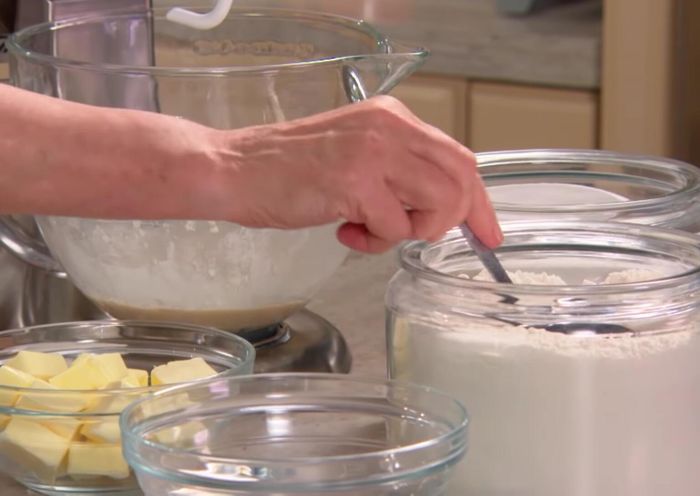Panettone, the iconic Italian sweet bread, is a festive treat synonymous with Christmas and joyous celebrations. Its history stretches back centuries, evolving from a simple bread to the luxurious, subtly sweet, and intensely flavorful masterpiece we know and love today. Characterized by its tall, dome-like shape and studded with candied fruit and raisins, panettone's airy texture is a testament to a long, slow rise, a process that infuses the bread with unparalleled richness and depth of flavor. The aroma alone is enough to transport you to a sun-drenched Italian piazza.
This delightful bread, however, can seem intimidating to the home baker. Fear not! We've broken down the process into manageable steps, guiding you through every stage, from preparing the starter to achieving that signature light-as-air crumb. Ready to experience the satisfaction of crafting your own authentic Panettone? Let’s dive into our step-by-step guide.
Tools Needed
- Mixing bowl
- Kitchen scale
- Mixer
- Damp towel or plastic wrap
- French paper baking panettone holders (or brown paper sandwich bag)
- Bamboo skewers
- Pedestal (optional)
Ingredients
- Warm whole milk: 1/3 cup
- Active dry yeast: 2 packages
- Granulated sugar: 1 tablespoon
- Bread flour: 12 ounces (approx. 2 1/2 cups)
- Sugar: 3 tablespoons
- Salt: 1 1/2 teaspoons
- Large eggs: 4
- Butter: 2 1/2 sticks (room temperature)
- Orange extract: 1/2 teaspoon
- Almond extract: 1/2 teaspoon
- Candied orange peel: 1 cup
- Golden raisins: 1 1/4 cups
Step-by-Step Instructions
Step 1. Prepare and Proof the Dough
- Combine warm milk, yeast, 1 tablespoon sugar, and about 1/2 cup flour in a bowl. Stir and let it proof for one hour, covering with a damp towel or plastic wrap.
- Combine bread flour, 3 tablespoons sugar, and salt in a bowl.
- Incorporate the sponge into the flour mixture.
- Mix the dough until smooth, then add eggs one at a time, mixing until incorporated.



- Add butter, one tablespoon at a time, until fully incorporated. This should take approximately 5 minutes.
- Add orange extract, almond extract, candied orange peel, and raisins to the dough.
Step 2. First Rise and Shaping
- Place the dough in an oiled bowl and refrigerate overnight.
- Divide the dough in half, shaping each half into a round. Place in prepared panettone molds (or brown paper sandwich bags).


Step 3. Second Rise, Glaze, and Bake
- Let rise in a warm place for 2 hours, or until almost doubled in bulk.
- Brush with egg glaze, sprinkle with pearl sugar and almonds (optional).
- Bake at 350°F (175°C) for approximately 50 minutes, or until golden brown.



Step 4. Cool and Serve
- Cool the panettone upside down between two jars using bamboo skewers to prevent it from collapsing.

Read more: Castagnaccio Recipe: Authentic Tuscan Gluten-Free Cake
Tips
- Use a damp towel or plastic wrap to prevent the sponge from drying out.
- Weighing ingredients ensures accuracy.
- Use room temperature butter for best results.
- Use pure extracts, not artificial.
- Don't overmix or press down on the dough after rising to preserve its airiness.
- Cooling the panettone upside down prevents it from caving in.
Nutrition
- N/A
FAQs
1. Can I substitute the candied fruit in Martha Stewart's Panettone recipe?
Yes, feel free to use your favorite dried fruits like cranberries, cherries, or even chocolate chips. Adjust the amount to your liking.
2. How long does the Panettone need to rise?
The rising time is crucial. It involves several stages, with a total rising time of around 12-18 hours, depending on the temperature.
3. What kind of flour is best for Martha Stewart's Panettone recipe?
The recipe typically calls for strong bread flour or a high-protein flour for the best rise and texture. Do not substitute with all-purpose flour.
With a little patience and attention to detail, you'll be rewarded with a magnificent homemade Panettone, bursting with flavor and boasting that signature airy crumb. The aroma alone will fill your kitchen with the warmth and joy of the holidays. Now, share your delicious creation with loved ones and savor the fruits of your labor!
